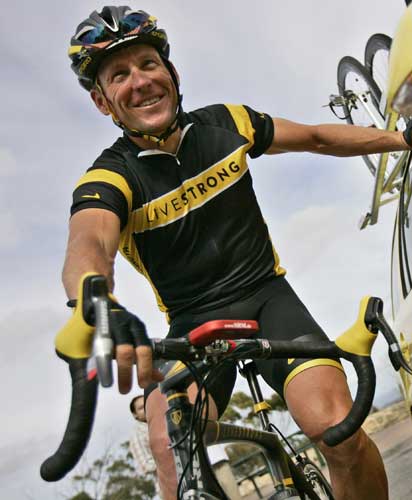Cycling: Lance's second coming more heaven than hell
Armstrong saddles up today for the Tour Down Under insisting he is no dope

Your support helps us to tell the story
From reproductive rights to climate change to Big Tech, The Independent is on the ground when the story is developing. Whether it's investigating the financials of Elon Musk's pro-Trump PAC or producing our latest documentary, 'The A Word', which shines a light on the American women fighting for reproductive rights, we know how important it is to parse out the facts from the messaging.
At such a critical moment in US history, we need reporters on the ground. Your donation allows us to keep sending journalists to speak to both sides of the story.
The Independent is trusted by Americans across the entire political spectrum. And unlike many other quality news outlets, we choose not to lock Americans out of our reporting and analysis with paywalls. We believe quality journalism should be available to everyone, paid for by those who can afford it.
Your support makes all the difference.It's not about the bike. It's about a global cancer awareness programme. And for Lance Armstrong it's also about proving yet again that his incredible achievements are not down to doping.
But the second coming of Armstrong also features a more relaxed man who can poke fun at himself; who rides for free for a greater cause.
Today, Armstrong begins his first professional race, the Tour Down Under, since winning the last of his seven consecutive Tour de France titles in 2005. The 10-year-old race is the first stop on the year's international circuit; a criterion followed by a largely undemanding six-stage race that potters through seaside towns and wine country in and around this sleepy Australian city.
"I go in with modest expectations, mixed with nerves mixed with excitement," Armstrong told a crowded press conference here yesterday. "But – not to sound like a slacker – with no major goals other than to make it through and get back into the rhythm of racing."
Armstrong has been welcomed as a messiah, with locals mobbing the 37-year-old Texan on training rides, in cafes and outside his hotel, prompting one reporter to ask if Armstrong felt like he was Jesus Christ.
"I've been called a lot of things," Armstrong answered with a broad grin. "But I don't know that He rode. He could do a lot of things apparently,but I don't know that He rode."
Mentally, Armstrong says he feels 25. Physically, it's not too bad either. "The only thing I can point to is a little bit of stiffness and soreness, which I suppose is normal for someone in their upper thirties," he said. "But the recovery's good, the power's good. I don't want to say I feel the same as in my early thirties, but I'm not far off."
The itch to return began during an amateur race in Colorado last August and gathered steam when Armstrong felt a "higher purpose". "There's no money here," said Armstrong, who is only paid appearance fees. "I'm doing it because I love to do it. I can't say that 2004, 2005 was like that. I think it became a job. I recaptured that passion. By me going out there and living my life and having fun and telling my story, I think it makes a difference."
Armstrong's well-documented health battle began in 1996, when he was diagnosed with testicular cancer that spread to his lungs and brain. He returned to competition a stronger cyclist, and has faced constant speculation over whether drugs fuelled his success. To counter that, he has hired an anti-doping expert, Don Catlin, to test him and post the results on a soon-to-be-available website. "It is the most comprehensive anti-doping plan in the history of sport," said Armstrong, who has been tested12 times by Catlin since announcing his comeback in September.
Cancer awareness is the focus of Armstrong's comeback. His black and yellow bike is dedicated to his Livestrong cancer foundation. On the frame is the number 27.5 – representing in millions the number of people worldwide to die of cancer during his retirement. "It's a staggering number when you think of it," Armstrong said. "It seems like I've been off the bike for a long time, but it's only been three- and-a-half years, and in the meantime more people than live in this entire country [Australia] are gone."
Armstrong is riding for the Astana team, run by his long-time collaborator Johan Bruyneel. And in a sign of his new outlook, Armstrong says he is happy to play second fiddle to the team's lead rider, Alberto Contador, who won the 2007 Tour de France, rather than chase an eighth title.
"I did not call Johan and say 'I want you to guarantee me leadership'," Armstrong explained. "I just wouldn't do that. That's not the way cycling works. There's a very good chance that I roll up to the Tour as the fourth-best guy on the team."
After Adelaide, Armstrong tackles the Tour of California, Milan-San Remo, the Tour of Flanders, the Giro del Trentino, the Giro d'Italia and then the Tour de France. The only complication is that his girlfriend, Anna Hansen, is expecting his fourth child in June. Unlike the three children Armstrong had with his ex-wife, Kristin, this baby was naturally conceived.
The new Armstrong relishes a full life; its ups and downs. And he is prepared to run the risk of his sporting legacy being overshadowed by a disastrous comeback.
"From a sporting perspective, yes, there's a great risk, and it might happen," he admitted. "But from a human perspective and a cause perspective, it's well worth the sporting risk."
Join our commenting forum
Join thought-provoking conversations, follow other Independent readers and see their replies
Comments